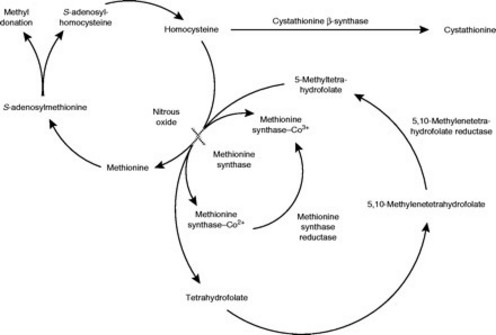(hyperhomocysteinemia)
Prevalence: 1/60,000 to 1/300,000. Autosomal recessive transmission. Second commonest anomaly in the metabolism of amino acids (after phenylketonuria). It involves the catabolism of methionine.
Three different forms according to the deficient enzyme:
- type I (95 % of cases): deficiency in cystathionine - β - synthase (mutation of the CBS gene on chromosome 21q22.3). Marfanoid physical appearance (slim, tall with long arms and legs). Dislocation of the lens, scoliosis, pectus excavatum, early coronary artery disease related to the elevation of blood levels of methionine, risk of arterial and venous thrombotic accidents, mental retardation, cerebral infarction.
Treatment: low-protein (methionine 150-200 mg/day) diet supplemented with vitamin B6, vitamin B12 and betaine
- type II: tetrahydrofolate methyltransferase deficiency: homocystinuria with hypomethionemia. Seizures, microcephaly, recurrent apnea.
- type III: tetrahydrofolate reductase deficiency [MIM 236 250] (see this term)
Normal blood level: 7 to 10 µmol/L. Mild hyperhomocysteinemia if 15 to 30 µmol/L, severe hyperhomocysteinemia if > 100 µmol/L.

Anesthetic implications:
significant risk of arterial and venous thrombosis: postpone elective surgery if total homocysteinemia is too high. Provide IV electrolytic glucose-containing fluids and check blood glucose levels as high blood levels of methionine lower glycemia. Avoid N2O because it inhibits the action of methionine synthase and favors a temporary increase in the homocysteine blood level.
In healthy children 2 to 12 years of age, exposure to 60 % of N2O for more than two hours results in a median 25 % increase of the level of homocysteine, 24 hours after anesthesia; the longer the duration of N2O exposure and the lower the preoperative level of vitamin B12,the greater the increase in homocysteine.
References :
- Lowe S, Johnson DA, Tobias JD.
Anesthetic implications of the child with homocystinuria.
J Clin Anesth 1994; 6:142-4.
- Saboul C, Darteyre S, Ged C, Fichtner C, Gay C, Stephan J-L.
Inaugural cerebral sinovevous thrombosis revealing homocystinuria in a 2-year-old boy.
J Child Neurol 2015; 30: 107-112.Kar P, Chintha SK, Durga P, Gopinah R. Pectus carinatum repair in an adolescent with hyperhomocystinaemia: anaesthetic implications. Indian J Anaesth 2017; 60: 873-5
- Pichardo D, Luginbuehl IA, Shakur Y, Wales PW, El-Sohemy A, O’Connor DL.
Effect of nitrous oxide exposure during surgery on the homocysteine concentrations of children.
Anesthesiology 2012 ; 117 : 15-21
- Myles PS, Chan MTV, Leslie K, Peyton P, Paech M, Forbes A.
Effect of nitrous oxide on plasma homocysteine and folate in patients undergoing major surgery.
Br J Anaesth 2008; 100:780-6.
- Nagele P, Zeugswetter B, Wiener C, Burger H, Hüpfl M, Mittlböck M, Födinger M.
Influence of methyltetrahydrofolate reductase gene polymorphisms on homocysteine concentrations after nitrous oxide anesthesia.
Anesthesiology 2008; 109:36-43.
- Morris AAM, Kozich V, Santra S, Andrai G et al.
Guidelines for the diagnosis and management of cystathionine-β-synthase deficiency.
J Inherit Metab Dis 2017; 40: 49-74.
Updated: January 2019